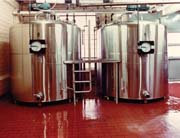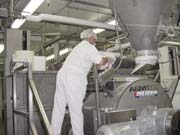
"There was a football-field sized area of half-liter shakers to emulate the motions of researchers who used to shake test tubes of those organisms to start growth," recalls Calabrese, a professor of chemical engineering at the University of Maryland in College Park. "They had to use all those shakers to produce the quantities they needed because, if they tried to do it in a 50-gallon batch, they couldn't recreate the kind of mixing that occurred when someone shook a vial by hand."
Understanding the dynamics of mixing is more than passing interest for Calabrese. As director of the university's High Shear Mixing Research Program, he is applying Laser Doppler Anemometry (LDA), computational fluid dynamics (CFD) and other analytic tools to better understand how a powder, liquid or combination of the two behave inside a rotor-stator mixing device. The program isn't academic: it is funded and advised by a board that includes mixer manufacturers and industrial firms such as DuPont and Procter & Gamble who are using the data to redesign their equipment and better predict and control their processing outcomes.
Decades of experience take a lot of the uncertainty out the equation with stirred vessels and static mixers.
Rotor-stator devices, on the other hand, have much shorter track records, and that can mean long learning curves and painful trial and error for new products when processors use these high-shear, in-line mixing devices. New formulations involving different ingredients further complicate process optimization.
"If you don't know what the energy fields are like at different points in the process or how the flow field is going to change as you scale up to bigger patches, it's hard to get the consistent results you want," notes Calabrese. The consortium's goal is to bring theoretical tools to bear in predicting those outcomes.
The expectation is that this type of research will yield performance criteria for this class of mixing devices and a foundation for equipment specifications for various processes. Similar mathematical models for static mixers have existed for years. Thirty years ago, the engineers at St. Cloud, Minn.-based DCI developed the mathematical calculations that consider turnover rate, turbine turbulence and product characteristics that DCI engineers use today in computer models that design mixing tanks for food, dairy, beverage, pharmaceutical and cosmetics clients, according to DCI's Chuck Leonard.

In-line mixing isn't very practical in many operations, and the reasons extend beyond the mixing unit itself. For example, so-called no-time dough for bread and roll production was tried without success in commercial bakeries. High shear produced inferior products. In addition, bread lines are geared to handle doughs mixed in horizontal mixers and then staged in troughs before sheeting and makeup.
The same infrastructure considerations enable static mixers to retain their dominance in the food industry, even among new installations. Higher speed mixers are being developed to even when the process doesn't call for that," DCI's Leonard notes. If gentle handling and uniformity are the priorities, a system like DCI's dual-agitated mix tank is more appropriate. Since its founding as Dairy Craft Inc. in 1955, DCI has built processing tanks, first for the food industry and then pharmaceutical manufacturers, cosmetics makers and others who wanted tanks that also could mix product.

"Processed cheese is an area where we do everything in-line," Beaudette says. "More people are doing flavored milk with in-line, too, using an adductor with a hopper."
But flavored milk is a fairly recent application, and the powders used can present particular challenges. Admix helped Stonyfield Farm in neighboring Londonderry set up its in-line yogurt system a few years ago. By eliminating a batch-blending step, Stonyfield was able to keep up with blossoming sales in a facility with a limited footprint.
To blend and reconstitute powdered milk, ice cream mix and flavored milk formulations, another option is a high-speed static blender like the Breddo Likwifier.
The Likwifier is most often used for a rapid hydration of solids, reconstitution of powder like lowfat milk powder and in the use of ice cream mix," says Bill Wade, equipment director at American Ingredients. "In an ice cream plant it is used to knock down the air that it created at the packaging location.
"When an ice cream freezer packaging area jams you can't shut off the freezer, so a lot of manufacturers will divert it into a Liquifier. It's jacketed with warm water or it de-aerates it and converts it back into a mix pumped back to the holding tank to be reworked."
Wade says in-line systems, particularly those that utilized vacuum can offer more functions than ever before, but they still have some limitations.
"In-line systems have a tendency to clog and bog down," he says. "You can't dump 100 lbs of dry powder into it. For that kind of use the Liquifier is fast and the mix is lump free."
A version of this article appeared in Food Engineering magazine.